
Browse an alphabetical list of photographs. These historical images portray people, places, and events before, during, and after World War II and the Holocaust.
<< Previous | Displaying results 101-125 of 125 for "Photo" | Next >>
Cover of a memorial booklet for Lisa Derman (Lisa Derman: An Extraordinary Woman, An Extraordinary Life, published by Louis Weber Publications International, Ltd.).

Sigmund Freud: Massenpsychologie und Ich-Analyse, cover. In 1933, Nazi students at more than 30 German universities pillaged libraries in search of books they considered to be "un-German." Among the literary and political writings they threw into the flames were all the works of Sigmund Freud that were published by 1933.

Cover of an antisemitic German children's book titled Trust No Fox in the Green Meadow and No Jew on his Oath, published by Der Stürmer-Verlag (publishing company of Julius Streicher). Germany, 1936.
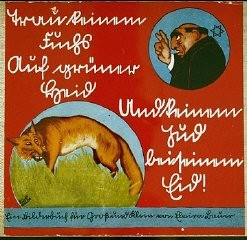
Cover of an underground Yiddish newspaper, Jugend Shtimme (Voice of Youth). Writing on the bottom of the cover reads: "Fascism must be smashed." Warsaw ghetto, Poland, January–February 1941.

The cover of a diary written by Elizabeth Kaufmann while living with the family of Pastor André Trocmé in Le Chambon-sur-Lignon. Le Chambon-sur-Lignon, France, 1940–41.
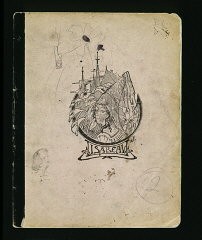
The International Jew, based largely on the Protocols of the Elders of Zion, sold more than 500,000 copies and was translated into at least 16 languages. Published in Dearborn, Michigan, United States, 1920.
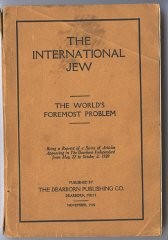
The Secrets of the Wise Men of Zion is the first documented version of the Protocols of the Elders of Zion published outside of Russia. Published in Charlottenburg, Germany, 1920.
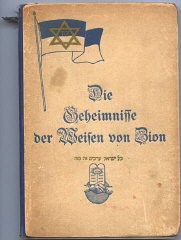
Many journalists covered the trial of Adolf Eichmann in Jerusalem. May 30, 1961.
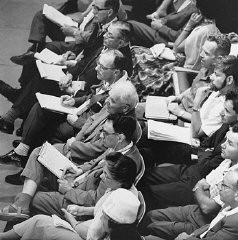
Cremation of corpses at Auschwitz-Birkenau. This photograph was taken clandestinely by prisoners in the Sonderkommando. Poland, summer 1944.
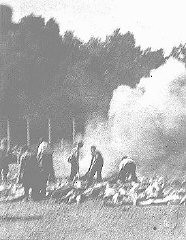
Charred remains of corpses near crematoria in the Majdanek camp, after liberation. Poland, after July 22, 1944.
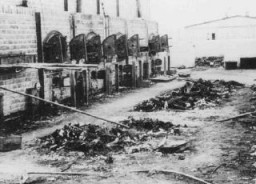
The crematoria at Dachau concentration camp, soon after the liberation of the camp. Germany, after April 29, 1945.
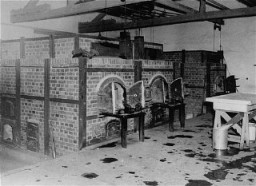
The crematoria at the Gusen camp, a subcamp of Mauthausen concentration camp, still held human remains after liberation. Austria, May 5, 1945.
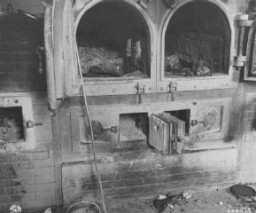
A crematorium at the Majdanek camp, outside Lublin. The photograph was taken after the Soviet liberation of Lublin/Majdanek in July 1944. Poland, date of photograph uncertain.
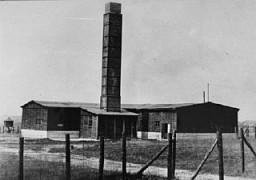
American soldiers finish their inspection of the Dachau camp's first crematorium. Dachau, Germany, November 18, 1945.
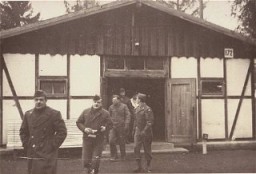
The crematorium building at the Flossenbürg concentration camp. Flossenbürg, Germany, May 1945.
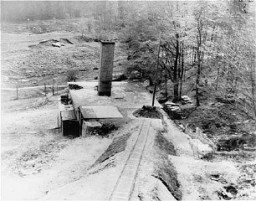
A survivor stokes smoldering human remains in a crematorium oven that was still lit in the Dachau camp. Photograph taken upon the liberation of the camp. Dachau, Germany, April 29-May 1, 1945.
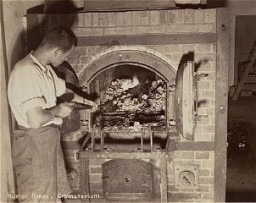
Crematorium oven used in the Bergen-Belsen concentration camp. Photograph taken after the liberation of teh camp. Bergen-Belsen, Germany, April 28, 1945.
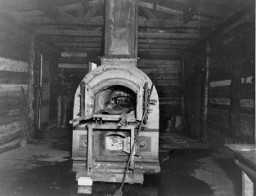
After the liberation of the Flossenbürg camp, a US Army officer (right) examines a crematorium oven in which Flossenbürg camp victims were cremated. Flossenbürg, Germany, April 30, 1945.

Infantryman of the US 89th Division cross the Rhine River in assault boats near St. Goar, Germany. March 26, 1945. US Army Signal Corps photograph taken by A. Graham.
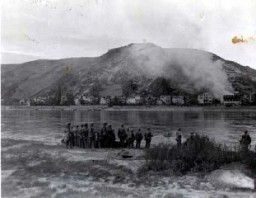
GIs keep low inside a landing craft during an assault across the Rhine at Oberwesel, Germany. March 22, 1945. US Army Signal Corps photograph.
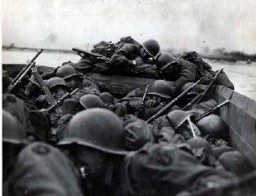
Germans in front of a Jewish-owned department store in Berlin during the anti-Jewish boycott. Berlin, Germany, April 1, 1933.
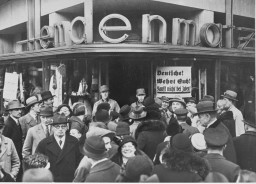
Jewish refugees, part of the Brihah movement (the postwar westward mass flight of Jews from eastern Europe), sleep on a crowded floor on the way to displaced persons camps in the American occupation zone. Seltz, Germany, 1947.
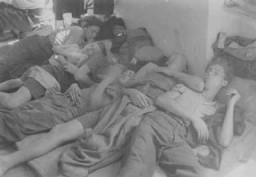
Cuban immigration papers issued to Ella Schatz, who had obtained passage aboard the Orinoco. On May 27, 1939, the Orinoco left Hamburg with 200 passengers bound for Cuba. Informed by radio of the difficulties other ships carrying refugees were facing in Havana, the captain of the Orinoco diverted the ship to waters just off Cherbourg, France, where it remained for days. The 200 refugees ultimately returned to Germany in June 1939. Their fate remains unknown.
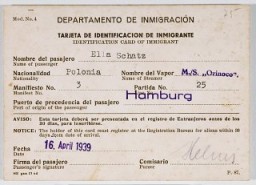
Jewish refugee youths, prevented by the British from landing in Palestine, learn sewing at a detention camp. The machines were provided by the American Jewish Joint Distribution Committee (JDC). Cyprus, 1947.
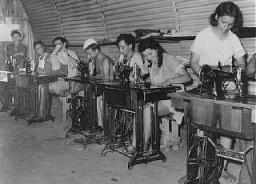
Czech Jews are deported from Bauschovitz to Theresienstadt ghetto. Czechoslovakia, between 1941 and 1943.

We would like to thank Crown Family Philanthropies, Abe and Ida Cooper Foundation, the Claims Conference, EVZ, and BMF for supporting the ongoing work to create content and resources for the Holocaust Encyclopedia. View the list of donor acknowledgement.